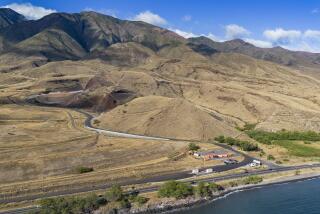Hawaii ups ante on penalties for damaging coral
- Share via
HONOLULU — Wrecking coral will cost you in Hawaii.
A Maui tour company is paying the state nearly $400,000 for damaging more than 1,200 coral colonies when one of its boats sank at Molokini, a pristine reef and popular diving spot. Another tour operator faces penalties for wrecking coral when it illegally dropped an anchor on a Maui reef.
The state plans to sue the U.S. Navy to seek compensation for coral ruined when a guided missile cruiser the length of two football fields ran aground near Pearl Harbor in February.
The state began issuing fines two years ago as part of its efforts to punish those who damage a resource crucial to Hawaii’s fragile environment and tourism, the state’s No. 1 industry.
“People are going to have to be more careful out here, because it if keeps getting damaged, we’re going to lose it,” said Laura Thielen, chairwoman of the state Board of Land and Natural Resources, which decides how much to fine. “We have to take some very strong action or else it’s going to be too late.”
Hawaii is home to 84% of all coral under U.S. jurisdiction. About 15% of U.S. coral is in state waters surrounding the main Hawaiian islands from Niihau to the Big Island. An additional 69% is in the Northwestern Hawaiian Islands -- a stretch of mostly uninhabited atolls President George W. Bush made a national marine monument in 2006.
Coral reefs provide vital habitats for fish, help protect shoreline areas during storms and support a thriving snorkeling and scuba diving industry.
Experts say coral reefs in the marine monument are in good shape. But those near the main Hawaiian island population centers are under pressure from sediment in runoff, overfishing and invasive algae.
Careless ocean users, who can kill a 500-year-old coral in five minutes, are another danger.
“Each one may be considered fairly small. But when you add them together, then the impact gets to be even greater,” said University of Hawaii coral reef expert Robert Richmond.
Kuulei Rodgers, a Hawaii Institute of Marine Biology assistant researcher, said injured corals will have a harder time recovering from global warming and rising levels of carbon dioxide that the oceans are absorbing amid growing greenhouse gas emissions.
“It’s the same as if when a disease hits people, it’s the weaker ones that will normally be the ones that suffer the high mortality,” Rodgers said.
The state imposed its first-ever fine for breaking coral in June 2007, when it ordered Lahaina-based tour operator Crystal Seahorse to pay $7,300 for illegally entering a natural area reserve and breaking 11 coral specimens there.
Hawaii had the legal authority to impose such fines before, but it preferred to simply educate offenders about reefs and have them assist with the cost of restoration. It shifted course after realizing this wasn’t prompting people to take necessary precautions around coral.
Maui Snorkel Charters, which runs tours under the name Maui Dive Shop, is paying the largest fine assessed so far.
In 2006, its Kai Anela tour boat headed to Molokini with 15 snorkelers and a captain who had just three days of training. No tourists were hurt when the ship sank after developing mechanical problems, but the company tripled the original coral damage area by bungling salvage attempts.
The state’s staff biologist estimates the area will take 80 years to recover.
Maui Snorkel Charters is paying $396,000 in a settlement, with part of the money up front and the rest in installments through 2011. The company apologized, and the Kai Anela is back in service.
The Navy is another target, for coral wrecked over 6 to 10 acres when the Port Royal ran aground.
The Navy has already spent nearly $40 million on ship repairs and some $7 million restoring the reef, including dispatching scuba divers to help reattach more than 5,000 broken coral colonies.
Florida, which has 2% of U.S. coral -- the most of any state after Hawaii -- is also moving to shield the resource.
Under the newly passed Coral Reef Protection Act, approved by the Legislature this year, Florida may fine culprits up to $250,000 and sue offenders for unlimited compensatory damages. Until the law, which took effect July 1, Florida had to seek compensation through the courts.
The federal government has in the past fined offenders millions of dollars for coral wrecked in marine sanctuaries.
Tori Cullins, co-owner of Wild Side Specialty Tours in Waianae, Hawaii, supports fines.
“Unless you hit people in the pocketbook, I don’t think it’s going to matter much,” said Cullins, who operates marine mammal viewing tours.
--
The AP’s Brian Skoloff in West Palm Beach, Fla., contributed to this report.
More to Read
Sign up for Essential California
The most important California stories and recommendations in your inbox every morning.
You may occasionally receive promotional content from the Los Angeles Times.










